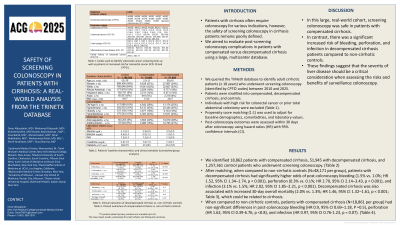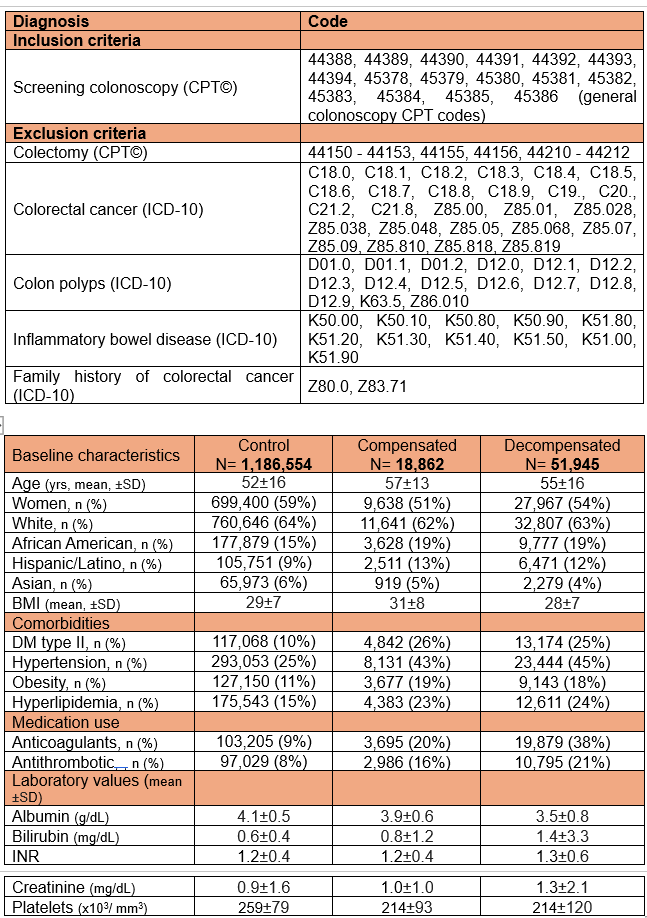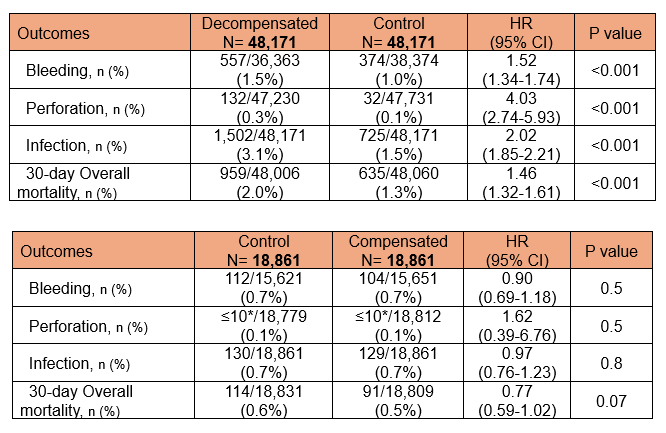Sunday Poster Session
Category: General Endoscopy
P0839 - Safety of Screening Colonoscopy in Patients With Cirrhosis: A Real-World Analysis From the TriNetX Database
Sunday, October 26, 2025
3:30 PM - 7:00 PM PDT
Location: Exhibit Hall


Mohamed Eldesouki, MD
Saint Michael's Medical Center, New York Medical College
Newark, NJ
Presenting Author(s)
Mohamed Eldesouki, MD1, Ahmed Ibrahim, MD2, Hazem Abosheaishaa, MD3, Firas Bahdi, MD4, Ahmed Salem, MD5, Omar Abdelhalim, MD6, Mohammad Adam, MD, MSc7, Sherif Andrawes, MD8
1Saint Michael's Medical Center, New York Medical College, Newark, NJ; 2Medical University of South Carolina, Charleston, SC; 3Mount Sinai West, Icahn School of Medicine at Mount Sinai, Queens, NY; 4David Geffen School of Medicine at UCLA, Los Angeles, CA; 5Maimonides Medical Center, Brooklyn, NY; 6Icahn School of Medicine at Mount Sinai, Queens, NY; 7University of Missouri - Kansas City School of Medicine, Kansas City, MO; 8Staten Island University Hospital, Northwell Health, Staten Island, NY
Introduction: Patients with cirrhosis often require colonoscopy for various indications, however, the safety of screening colonoscopy in cirrhosis patients remains poorly defined. We aimed to evaluate post-screening colonoscopy complications in patients with compensated versus decompensated cirrhosis using a large, multicenter database
Methods: We queried the TriNetX database to identify adult cirrhotic patients (≥ 18 years) who underwent screening colonoscopy (identified by CPT© codes) between 2010 and 2025. Patients were stratified into compensated, decompensated cirrhosis, and controls. Individuals with high risk for colorectal cancer or prior total abdominal colectomy were excluded (Table 1). Propensity score matching (1:1) was used to adjust for baseline demographics, comorbidities, and laboratory values. Post-colonoscopy outcomes were assessed within 30 days after colonoscopy using hazard ratios (HR) with 95% confidence intervals (CI).
Results: We identified 18,862 patients with compensated cirrhosis, 51,945 with decompensated cirrhosis, and 1,257,361 control patients who underwent screening colonoscopy. (Table 2)
After matching, when compared to non-cirrhotic controls (N=48,171 per group), patients with decompensated cirrhosis had significantly higher odds of post-colonoscopy bleeding (1.5% vs. 1.0%; HR 1.52, 95% CI 1.34–1.74, p < 0.001), perforation (0.3% vs. 0.1%; HR 2.70, 95% CI 2.14–3.43, p < 0.001), and infection (3.1% vs. 1.5%; HR 2.02, 95% CI 1.85–2.21, p < 0.001). Decompensated cirrhosis was also associated with increased 30-day overall mortality (2.0% vs. 1.3%; HR 1.46, 95% CI 1.32–1.61, p < 0.001; Table 3), which could be related to cirrhosis.
When compared to non-cirrhotic controls, patients with compensated cirrhosis (N=18,861 per group) had non-significant differences in post-colonoscopy bleeding (HR 0.9, 95% CI 0.69–1.18, P =0.5), perforation (HR 1.62, 95% CI 0.39-6.76, p <0.8), and infection (HR 0.97, 95% CI 0.76-1.23, p = 0.07). (Table 4).
Discussion: In this large, real-world cohort, screening colonoscopy was safe in patients with compensated cirrhosis. In contrast, there was a significant increased risk of bleeding, perforation, and infection in decompensated cirrhosis patients compared to non-cirrhotic controls. These findings suggest that the severity of liver disease should be a critical consideration when assessing the risks and benefits of surveillance colonoscopy.


Disclosures:
Mohamed Eldesouki, MD1, Ahmed Ibrahim, MD2, Hazem Abosheaishaa, MD3, Firas Bahdi, MD4, Ahmed Salem, MD5, Omar Abdelhalim, MD6, Mohammad Adam, MD, MSc7, Sherif Andrawes, MD8. P0839 - Safety of Screening Colonoscopy in Patients With Cirrhosis: A Real-World Analysis From the TriNetX Database, ACG 2025 Annual Scientific Meeting Abstracts. Phoenix, AZ: American College of Gastroenterology.
1Saint Michael's Medical Center, New York Medical College, Newark, NJ; 2Medical University of South Carolina, Charleston, SC; 3Mount Sinai West, Icahn School of Medicine at Mount Sinai, Queens, NY; 4David Geffen School of Medicine at UCLA, Los Angeles, CA; 5Maimonides Medical Center, Brooklyn, NY; 6Icahn School of Medicine at Mount Sinai, Queens, NY; 7University of Missouri - Kansas City School of Medicine, Kansas City, MO; 8Staten Island University Hospital, Northwell Health, Staten Island, NY
Introduction: Patients with cirrhosis often require colonoscopy for various indications, however, the safety of screening colonoscopy in cirrhosis patients remains poorly defined. We aimed to evaluate post-screening colonoscopy complications in patients with compensated versus decompensated cirrhosis using a large, multicenter database
Methods: We queried the TriNetX database to identify adult cirrhotic patients (≥ 18 years) who underwent screening colonoscopy (identified by CPT© codes) between 2010 and 2025. Patients were stratified into compensated, decompensated cirrhosis, and controls. Individuals with high risk for colorectal cancer or prior total abdominal colectomy were excluded (Table 1). Propensity score matching (1:1) was used to adjust for baseline demographics, comorbidities, and laboratory values. Post-colonoscopy outcomes were assessed within 30 days after colonoscopy using hazard ratios (HR) with 95% confidence intervals (CI).
Results: We identified 18,862 patients with compensated cirrhosis, 51,945 with decompensated cirrhosis, and 1,257,361 control patients who underwent screening colonoscopy. (Table 2)
After matching, when compared to non-cirrhotic controls (N=48,171 per group), patients with decompensated cirrhosis had significantly higher odds of post-colonoscopy bleeding (1.5% vs. 1.0%; HR 1.52, 95% CI 1.34–1.74, p < 0.001), perforation (0.3% vs. 0.1%; HR 2.70, 95% CI 2.14–3.43, p < 0.001), and infection (3.1% vs. 1.5%; HR 2.02, 95% CI 1.85–2.21, p < 0.001). Decompensated cirrhosis was also associated with increased 30-day overall mortality (2.0% vs. 1.3%; HR 1.46, 95% CI 1.32–1.61, p < 0.001; Table 3), which could be related to cirrhosis.
When compared to non-cirrhotic controls, patients with compensated cirrhosis (N=18,861 per group) had non-significant differences in post-colonoscopy bleeding (HR 0.9, 95% CI 0.69–1.18, P =0.5), perforation (HR 1.62, 95% CI 0.39-6.76, p <0.8), and infection (HR 0.97, 95% CI 0.76-1.23, p = 0.07). (Table 4).
Discussion: In this large, real-world cohort, screening colonoscopy was safe in patients with compensated cirrhosis. In contrast, there was a significant increased risk of bleeding, perforation, and infection in decompensated cirrhosis patients compared to non-cirrhotic controls. These findings suggest that the severity of liver disease should be a critical consideration when assessing the risks and benefits of surveillance colonoscopy.

Figure: Table 1. Codes used to identify colorectal cancer screening tests as well as patients at increased risk for colorectal cancer (ICD-10 and CPT©).
Table 2. Patients’ baseline characteristics and clinical variables (unmatched group analysis).
Table 2. Patients’ baseline characteristics and clinical variables (unmatched group analysis).

Figure: Table 3. Clinical outcomes of decompensated cirrhosis vs. non-cirrhotic controls
Table 4. Clinical outcomes of compensated cirrhosis vs. non-cirrhotic controls.
*To protect patient privacy, numbers are rounded up to 10. This may impact results, particularly for small cohorts and infrequent outcomes.
Table 4. Clinical outcomes of compensated cirrhosis vs. non-cirrhotic controls.
*To protect patient privacy, numbers are rounded up to 10. This may impact results, particularly for small cohorts and infrequent outcomes.
Disclosures:
Mohamed Eldesouki indicated no relevant financial relationships.
Ahmed Ibrahim indicated no relevant financial relationships.
Hazem Abosheaishaa indicated no relevant financial relationships.
Firas Bahdi indicated no relevant financial relationships.
Ahmed Salem indicated no relevant financial relationships.
Omar Abdelhalim indicated no relevant financial relationships.
Mohammad Adam indicated no relevant financial relationships.
Sherif Andrawes indicated no relevant financial relationships.
Mohamed Eldesouki, MD1, Ahmed Ibrahim, MD2, Hazem Abosheaishaa, MD3, Firas Bahdi, MD4, Ahmed Salem, MD5, Omar Abdelhalim, MD6, Mohammad Adam, MD, MSc7, Sherif Andrawes, MD8. P0839 - Safety of Screening Colonoscopy in Patients With Cirrhosis: A Real-World Analysis From the TriNetX Database, ACG 2025 Annual Scientific Meeting Abstracts. Phoenix, AZ: American College of Gastroenterology.
